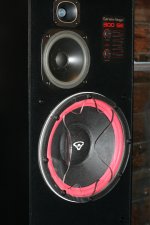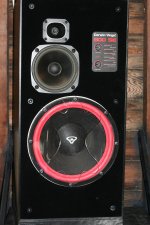Hey everyone,
I just wanted to share this one. I was looking into ways to improve dispersion of large diameter woofers to increase the crossover frequency. I have a set of Cerwin Vega 300 SE speakers for playing around with. They are perfect because the woofers are run full range.
I used a piece of 3/8 cast acrylic, cut it out with a jigsaw. Flame polished the edges and used a propane torch to bend the middle in. I'll post the template.
The results are better than I expected. The waveguides completely removed the 7db peak at 1.5k. the speakers sound much more open and the sweet spot has changed from about 12" to several feet. I didn't do much off axis measuring, since I was using my laptop for the tone generator and it just didn't have enough output to get any consistent results.
I thought the results where pretty amazing so I had my wife come in, and do a blind A-B comparison. She said the one sounded richer, so the wave guides have 2 positive votes. I think these could be the answer for a lot of problems.
Jordon
I just wanted to share this one. I was looking into ways to improve dispersion of large diameter woofers to increase the crossover frequency. I have a set of Cerwin Vega 300 SE speakers for playing around with. They are perfect because the woofers are run full range.
I used a piece of 3/8 cast acrylic, cut it out with a jigsaw. Flame polished the edges and used a propane torch to bend the middle in. I'll post the template.
The results are better than I expected. The waveguides completely removed the 7db peak at 1.5k. the speakers sound much more open and the sweet spot has changed from about 12" to several feet. I didn't do much off axis measuring, since I was using my laptop for the tone generator and it just didn't have enough output to get any consistent results.
I thought the results where pretty amazing so I had my wife come in, and do a blind A-B comparison. She said the one sounded richer, so the wave guides have 2 positive votes. I think these could be the answer for a lot of problems.
Jordon
Attachments
Last edited:
Measurements? I've done something similar with a pa speaker build I did for my basement. Works quite well to widen the directivity up high but of course break up is still an issue. Not what I'd want for my hi-fi but for something that gets loud with a fairly wide listening area it works well.
Here is a paper from 1958 (s. pg. 10 & 11):
http://www.harbeth.co.uk/library/Papers/Shorter1958a.pdf
Source: EON600 Series Products | JBL Professional
 Christoph
Christoph
http://www.harbeth.co.uk/library/Papers/Shorter1958a.pdf
An externally hosted image should be here but it was not working when we last tested it.
Source: EON600 Series Products | JBL Professional
 Christoph
ChristophA Diffraction Slot ...
... not a Waveguide.
WHG
... not a Waveguide.
WHG
Hey everyone,
I just wanted to share this one. I was looking into ways to improve dispersion of large diameter woofers to increase the crossover frequency. I have a set of Cerwin Vega 300 SE speakers for playing around with. They are perfect because the woofers are run full range.
I used a piece of 3/8 cast acrylic, cut it out with a jigsaw. Flame polished the edges and used a propane torch to bend the middle in. I'll post the template.
The results are better than I expected. The waveguides completely removed the 7db peak at 1.5k. the speakers sound much more open and the sweet spot has changed from about 12" to several feet. I didn't do much off axis measuring, since I was using my laptop for the tone generator and it just didn't have enough output to get any consistent results.
I thought the results where pretty amazing so I had my wife come in, and do a blind A-B comparison. She said the one sounded richer, so the wave guides have 2 positive votes. I think these could be the answer for a lot of problems.
Jordon
KEF Concord, circa 1966.
Nexo (still current)
 .
.
http://pdfpiw.uspto.gov/.piw?Docid=07596236&homeurl=http%3A%2F%2Fpatft.uspto.gov%2Fnetacgi%2Fnph-Parser%3FSect1%3DPTO2%2526Sect2%3DHITOFF%2526p%3D1%2526u%3D%25252Fnetahtml%25252FPTO%25252Fsearch-bool.html%2526r%3D8%2526f%3DG%2526l%3D50%2526co1%3DAND%2526d%3DPTXT%2526s1%3DNEXO.ASNM.%2526OS%3DAN%2FNEXO%2526RS%3DAN%2FNEXO&PageNum=&Rtype=&SectionNum=&idkey=NONE&Input=View+first+page
An externally hosted image should be here but it was not working when we last tested it.
Nexo (still current)

http://pdfpiw.uspto.gov/.piw?Docid=07596236&homeurl=http%3A%2F%2Fpatft.uspto.gov%2Fnetacgi%2Fnph-Parser%3FSect1%3DPTO2%2526Sect2%3DHITOFF%2526p%3D1%2526u%3D%25252Fnetahtml%25252FPTO%25252Fsearch-bool.html%2526r%3D8%2526f%3DG%2526l%3D50%2526co1%3DAND%2526d%3DPTXT%2526s1%3DNEXO.ASNM.%2526OS%3DAN%2FNEXO%2526RS%3DAN%2FNEXO&PageNum=&Rtype=&SectionNum=&idkey=NONE&Input=View+first+page
Last edited:
Because horns are the ultimate in dispersion control.
Interesting stuff, why are they not used more?
This interests me as a way to tame peaks in full range and midrange drivers, but I'm looking at a slightly different solution
In the 80s or early 90s Boston acoustics did something a little similar to this with one of their stand mounts. I think it was a diagonal bar which was somehow tuned to the offending frequency
In the 80s or early 90s Boston acoustics did something a little similar to this with one of their stand mounts. I think it was a diagonal bar which was somehow tuned to the offending frequency
I have CV woofers from old D7's I was using with a SEOS12 waveguide.
I used a generic "econowave" crossover, and had a bump at around 1.7 HZ or so just like your woofers. The original crossover for the d7 was set to around 600Hz and the bump didn't measure much on the factory CV speaker (I measured it).
But with the higher crossover point with the waveguide, it was pretty bad.
If I don't get rid of my D7's in my current move, I will try this technique to see if I can tame them (I don't like the CV woofers up high because I have limited passive crossover design skills and I can't tame the hump).
I hate to buy new woofers and passive crossover just to tame the bump, but even with the bump they sound really good with the seos12.
Honestly, I think with a properly built crossover the woofers would be great.
They have a simillar response and peak to the Dayton designer 12 which I believe was used by Bill Waslo in the early SEOS12 builds.
I just can't design passive crossovers (even with measuring equipment for FR and RE and PCD7!).
Take some measurements and see what is going on...
I used a generic "econowave" crossover, and had a bump at around 1.7 HZ or so just like your woofers. The original crossover for the d7 was set to around 600Hz and the bump didn't measure much on the factory CV speaker (I measured it).
But with the higher crossover point with the waveguide, it was pretty bad.
If I don't get rid of my D7's in my current move, I will try this technique to see if I can tame them (I don't like the CV woofers up high because I have limited passive crossover design skills and I can't tame the hump).
I hate to buy new woofers and passive crossover just to tame the bump, but even with the bump they sound really good with the seos12.
Honestly, I think with a properly built crossover the woofers would be great.
They have a simillar response and peak to the Dayton designer 12 which I believe was used by Bill Waslo in the early SEOS12 builds.
I just can't design passive crossovers (even with measuring equipment for FR and RE and PCD7!).
Take some measurements and see what is going on...
I have CV woofers from old D7's I was using with a SEOS12 waveguide.
I used a generic "econowave" crossover, and had a bump at around 1.7 HZ or so just like your woofers. The original crossover for the d7 was set to around 600Hz and the bump didn't measure much on the factory CV speaker (I measured it).
But with the higher crossover point with the waveguide, it was pretty bad.
If I don't get rid of my D7's in my current move, I will try this technique to see if I can tame them (I don't like the CV woofers up high because I have limited passive crossover design skills and I can't tame the hump).
I hate to buy new woofers and passive crossover just to tame the bump, but even with the bump they sound really good with the seos12.
Honestly, I think with a properly built crossover the woofers would be great.
They have a simillar response and peak to the Dayton designer 12 which I believe was used by Bill Waslo in the early SEOS12 builds.
I just can't design passive crossovers (even with measuring equipment for FR and RE and PCD7!).
Take some measurements and see what is going on...
Crossovers are one of the steeper learning curves in speakers, but it's not that hard to throw a notch at the thing- definitely don't use pre-made XOs. You can get help here and other places if you're willing to post measurements etc.
Yeah it's more of a phase shield than a waveguide. What it does to the frequency response will be very dependant on the cone breakup behaviour.
Widening beam width is not always desirable. I also see a lot of potential for the shield to resonate, especially when it is thin and covering a significant portion of a bass driver.Interesting stuff, why are they not used more?
Crossovers are one of the steeper learning curves in speakers, but it's not that hard to throw a notch at the thing- definitely don't use pre-made XOs. You can get help here and other places if you're willing to post measurements etc.
I have posted info here and on other websites, and people don't seem eager to help me much. Just basic advise so far, which has been helpful.
And I admit I have not tried too hard to get info in the last year or so.
I need to learn more about passive crossover design, so after my big move I might try to start another thread on here and other websites asking for all out help. I have not taken my SEOS12 project very serious, and will probably try to take on the project again in near future when I can sit down and get the data ready to share (and also buy crossover bits).
One of the factors effecting my lack of interest in taking PCD serious, is that I might be selling the CV D7 speakers in their original condition. If they don't sell, I am going to junk the speaker enclosures, and re-purpose the woofers. I also have some mid-range ribbons to play with and can use with the CV woofers. The woofers go to 800Hz no problem, and the midranges are easy to crossover in that region. So, might be a good learning project rather than the more complicated Seos12 waveguide/CD combo. Compression driver compensation is beyond me at this moment...
I won't post any more about my mess here, just trying to see what my options are and the OP has an interesting idea I am curious to see be explored further...
- Home
- Loudspeakers
- Multi-Way
- DIY woofer wave guides, They work!

